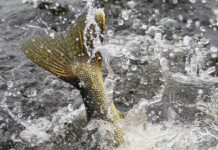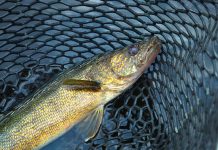THUNDER BAY – A new study conducted by the Ohio Division of Wildlife will evaluate loss of stocked fish from reservoirs by monitoring the movement of muskellunge through reservoir dams. Departure of fish from reservoirs by means other than angler harvest or natural death is known as “emigration” by fisheries biologists. Downstream emigration of fish is possible through dams because many reservoirs are open systems, built by impounding streams. Dams on reservoirs of this type are operated to allow water to pass through at specified rates to meet flood control, water supply, recreation and other needs.
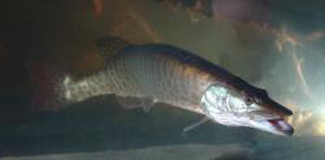 |
Fish Loss by Emigration
Fish loss by emigration can vary from reservoir-to-reservoir. The timing, amount, method, and rate of water passing through a dam can have a strong influence on whether fish stay in the reservoir or emigrate downstream below the dam. While most stocked fish stay put as planned, under some circumstances losses of stocked fish can be high. Naturally, that affects the quality of fishing, which is important in Ohio where 50% of all fishing trips are made to reservoirs.
In unique cases, emigration produces valuable tailwater fisheries below dams, such as the saugeye fisheries below Deer Creek and Paint Creek reservoirs. Biologists know this and stock these reservoirs with that purpose in mind. However, such desirable outcomes from emigration are rare and the usual result is fewer opportunities for anglers and a waste of stocked fish. Understanding the number of fish lost by emigration, as well as when and where emigration occurs, helps biologists develop better strategies for managing reservoir fisheries.
Studying the Muskie
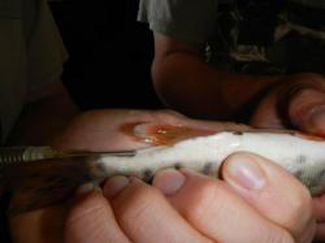
Implanting the PIT tag |
Muskellunge, also known as muskie, is a trophy sport fish maintained in reservoirs through annual stocking and will be the focus of the new study. These fish were chosen for the study because they are known to emigrate from reservoirs and are stocked at large enough sizes to allow biologists to tag them prior to stocking. Starting in 2013 and for the next 10 years, all of the nearly 20,000 muskie stocked in nine reservoirs statewide will be tagged prior to stocking. With anglers’ cooperation, this will help biologists better understand emigration and provide the bonus of learning more about the success of catch and release of stocked muskie. Alum Creek (Delaware County), Leesville (Carroll County), and Salt Fork (Guernsey County) reservoirs where chosen for the most detailed work in this study because they differ in water flow regimes and dam types and have historically high numbers of reported muskie catches.
Each muskie stocked in Alum Creek, Leesville, and Salt Fork will be implanted with a Passive-Integrated-Transponder (PIT) tag to provide detailed information about emigration. A PIT tag is about the size of a grain of rice and is implanted with a syringe just under the skin. These tags have the advantages of staying within the fish, remote detection, and providing unique identification allowing biologists to follow the history of each fish. PIT tags emit a signal when they are in the vicinity of a PIT tag reader, instantly providing a fish identification number and the time and date of detection.
The Division will monitor emigration of muskie by installing un-manned shore-based PIT tag readers below dams within the three study reservoirs. Automated readers will continuously scan for PIT tagged muskie leaving reservoirs and provide critical information such as the number of muskie emigrating and when they emigrate. These details can later be compared to environmental conditions such as rainfall and reservoir water levels, age of fish emigrating, and how dams are operated to release water.
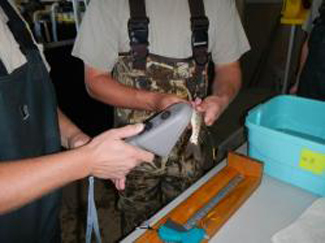
Scanning the PIT tag |
To learn more about the catch and release of muskie using PIT tags, a small number of the most successful anglers in Alum Creek, Leesville, and Salt Fork will be provided a hand-held PIT tag reader to monitor tagged muskie catches as well. These volunteers will provide supplemental details about PIT tagging that can be matched with additional information from T-bar tags, a second method that will be used at all reservoirs due to its lower cost.
Each T-bar tag will have a unique identification number and a contact phone number. This will allow any muskie captured during the study period to be reported. Anglers will be encouraged to report tag information along with catches they report in the Muskie Angler Log, the Division’s online reporting tool that anglers use to help track success of the muskie program. Catch reports of T-bar tagged fish will complement data collected from PIT tags by evaluating survival, harvest, catch, and recaptures of previously caught muskie within all reservoirs.
Together, PIT tag and T-bar tag data are expected to provide a detailed picture of the emigration issue for reservoir muskie fisheries. Using long-term information from muskie tag detection and catches will help Division biologists understand what happens to muskie after stocking and identify key areas where management actions may improve fishing. Preliminary work has begun to test tagging procedures and prepare for work at the Kincaid and London fish hatcheries next September.
By Kevin Page, Fisheries Biologist
Inland Fisheries Research Unit
Source: www.thefishingwire.com

